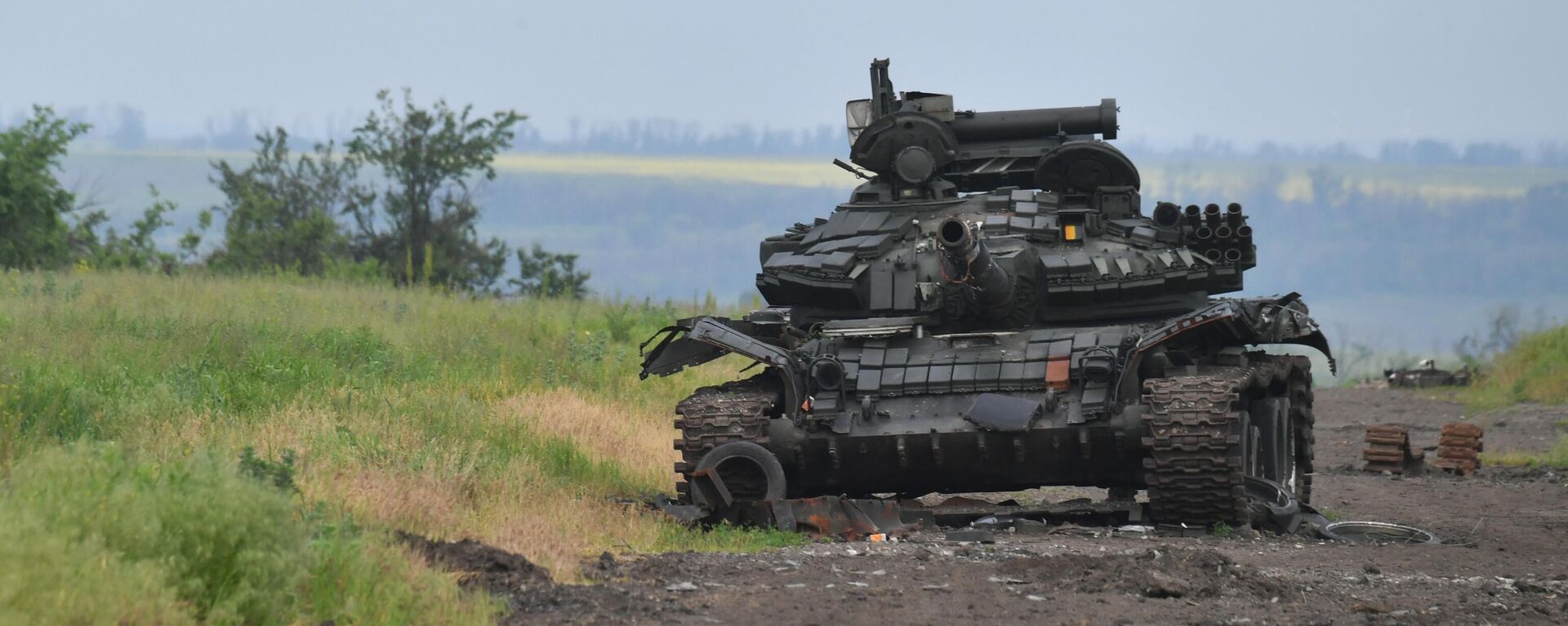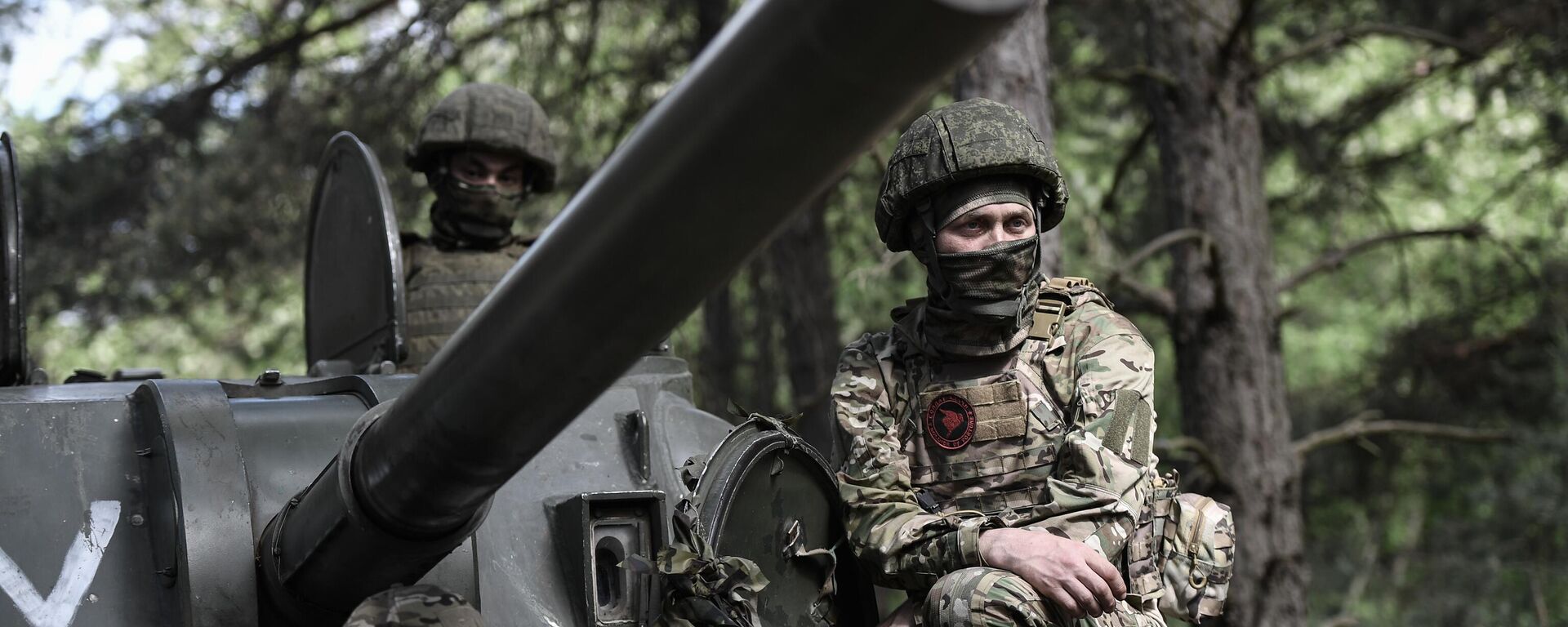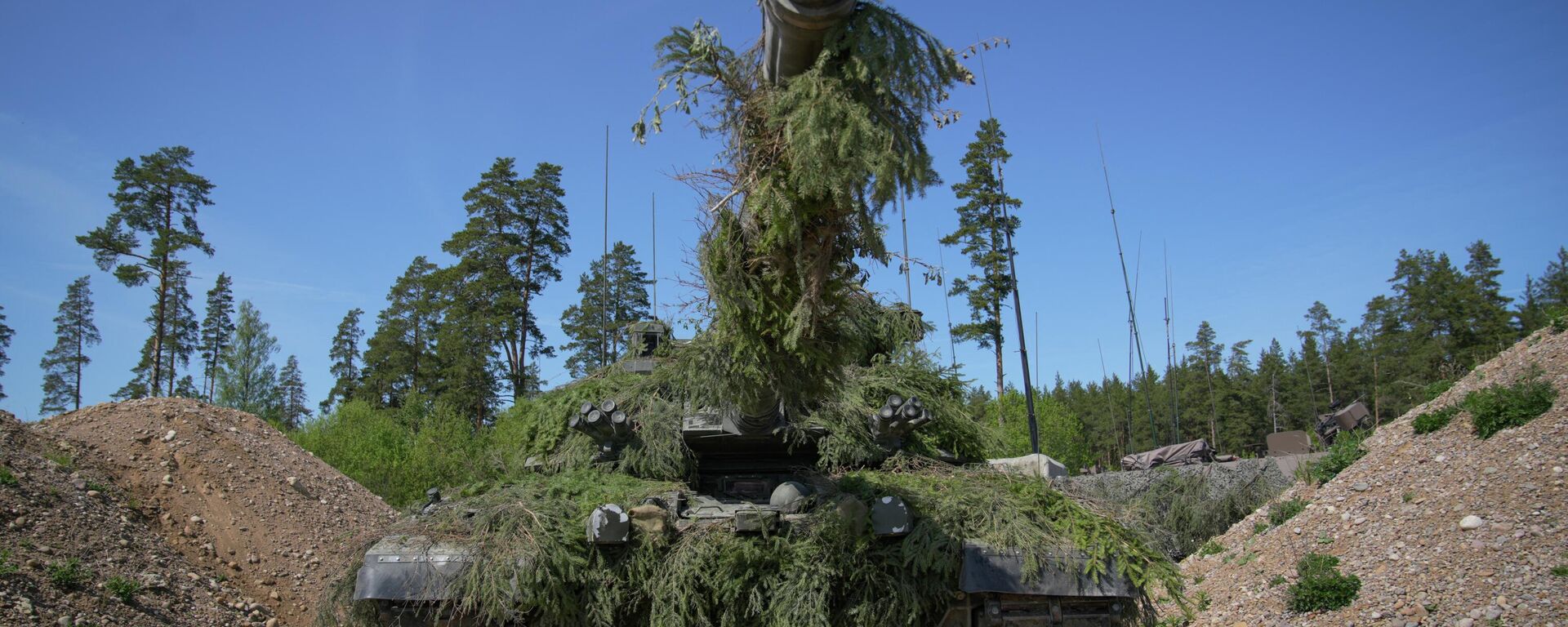https://sputnikglobe.com/20230910/ex-pentagon-analyst-reveals-russias-secret-weapon-against-nato-armor-in-tank-on-tank-duels-1113253334.html
Ex-Pentagon Analyst Reveals Russia’s Secret Weapon Against NATO Armor in Tank-on-Tank Duels
Ex-Pentagon Analyst Reveals Russia’s Secret Weapon Against NATO Armor in Tank-on-Tank Duels
Sputnik International
Predictions about tank warfare being a relic of the 20th century have turned out dead wrong, with Russia and NATO deploying hundreds of main battle tanks and thousands of other armored vehicles in Ukraine. Former Pentagon officer David T. Pyne shares his assessment of Russian tank forces’ capabilities against those of the Western alliance.
2023-09-10T11:52+0000
2023-09-10T11:52+0000
2023-09-10T13:24+0000
military
russia
ukraine
nato
pentagon
russian army
t-80
t-72
t-90
https://cdn1.img.sputnikglobe.com/img/07e7/06/10/1111223184_0:8:1084:618_1920x0_80_0_0_570072583aa65b029162b18ff6bf8cc7.png
Sunday marks Tankers' Day in Russia, a professional military holiday first established in 1946 to commemorate the Red Army tank commanders and crews who defended their country against the Nazi invaders and drove them back thousands of kilometers into the heart of Europe in 1945.Like many similar holidays, Tankers' Day is celebrated across much of the post-Soviet space, including Russia, Belarus, Kazakhstan, and even Ukraine (where it is now called "Tank Forces Day"). But while Russia and its Collective Security Treaty Organization allies have largely organized their tank forces by taking cues from their common Soviet past, Ukraine’s NATO-advised army has sought to take tank warfare in a different direction, toward the equipment, standards, and training regimen of the Western alliance.While modern Russia’s tank forces consist mostly of upgraded variants of late second and third generation tank designs like the T-72, T-80, and T-90, Ukraine’s forces, while also perfectly familiar with T-72s and T-80s, have now also been complemented by variants of the German Leopard 1 and Leopard 2 series of MBTs, British-made Challenger 2s, and soon, American M1 Abrams.Ukraine’s military stocked up on hundreds of NATO tanks and thousands of pieces of other Western armor, and sent tank crews to undergo weeks or months of intensive training in NATO countries in the spring, before launching its ill-fated counteroffensive on June 4. Three months, tens of thousands of lives, and hundreds of destroyed armored vehicles later, the counteroffensive has for the most part failed to breach even the first lines of the Russian defenses in Donbass, Zaporozhye, and Kherson.With Ukraine’s military continuing to suffer from a catastrophic lack of artillery, air, and intelligence support, NATO tanks have failed to live up to the expectations that they would be "miracle weapons" which could quickly cut through Russian defenses and ensure a speedy victory for Kiev. Instead, the large, more easily spotted Leopard and Challenger MBTs have proven just as easy for Russian forces to destroy using a combination of air-launched missiles, long range artillery, anti-tank mines, and drones, to the point where there have been repeated reports over the summer of Ukrainian hesitation to deploy the heavy armor during the counteroffensive.On top of that is Russia’s superiority in tank numbers.Recalling that Russia started out its special military operation in 2022 with over 13,000 relatively modern main battle tanks, from the T-72B series onward, most of them in reserve, Pyne noted that the US is thought to possess about 8,000 M1 Abrams, most of which are also in reserve.“Most of Russia’s tank fleet was in reserve storage before the war began, but more and more are being refurbished to reinforce Russian forces all along the front,” Pyne said.In the process, the Russian tanks are being equipped with improved fire control systems, superior optical sights, new thermal imaging channels and target tracking equipment, and communications systems designed to integrate them with the latest unmanned aerial surveillance systems.“The Russian Army currently uses four different tank models – the most numerous are the T-72B model tanks with the T-72B3M as the most modern variant, the T-80, which is the second-most produced model, and T-90 variants, most recently the T-90M,” the former Pentagon analyst said. Then there’s the T-14 Armata, Russia’s newest and most advanced, but least readily available, main battle tank.Delving into history, Pyne recalled that “the T-72 tank was designed to incorporate several, but not all the advanced design features of its revolutionary T-64 predecessor, including its 125 mm smoothbore cannon, the performance of which is on par with Western tanks, most of which mount 120 mm smoothbore cannons, while being cheaper to mass produce. The T-80 was a further development from the T-64, costing more to produce with more advanced technical features, with the T-80BVM as the most modern variant. The T-90 is a further development of the T-72 main battle tank and is believed to be somewhat more affordable than the T-80 models. The T-14 Armata incorporates a revolutionary unmanned turret allowing all the crew members to be in the hull in a heavily armored compartment. While it has been tested under combat conditions in Ukraine, it is the most expensive Russian tank and has been produced only in small numbers.”Russia has been a leader in the creation of cutting-edge tanks since the Soviet days, Pyne said, pointing to the “revolutionary design” of the T-54 from the immediate post-WWII period, which helped set the standard for the USSR and Russia’s production of nimble, heavily-armed MBTs with “comparable levels of armor protection” to their NATO counterparts, but weighing up to 25 tons less.Modern Russian tanks possess second-generation explosive reactive armor, with some equipped with ARENA active defenses to detect and stop anti-tank guided missiles, including Javelin top attack ATGMs. Like their Western counterparts, Russian tanks possess the capability to use depleted uranium shells to maximize destructive power, but unlike Ukraine, they haven’t been deployed, according to President Vladimir Putin.Asked to assess the overall performance of Russian tank forces in Ukraine, Pyne characterized it as “decidedly mixed,” largely due to constraints set “by the limited territorial objectives of the special military operation,” and the lack of any “large-scale offensives" on Russia's part "since summer 2022.” At the same time, he said, Russian forces including tanks “have excelled in defensive and artillery operations, inflicting much heavier casualties on Ukrainian forces” than those they themselves have taken.Going forward, the observer expects Russian tank forces' capabilities to continue to improve.
https://sputnikglobe.com/20230908/scott-ritter-ukrainian-counteroffensives-last-desperate-push-1113205046.html
https://sputnikglobe.com/20230910/as-russia-easily-destroys-western-armored-vehicles-in-ukraine-us-doubts-its-effectiveness---report--1113244261.html
https://sputnikglobe.com/20230907/western-wonder-weapons-wont-turn-the-tide-in-ukraine-1113177634.html
russia
ukraine
Sputnik International
feedback@sputniknews.com
+74956456601
MIA „Rosiya Segodnya“
2023
News
en_EN
Sputnik International
feedback@sputniknews.com
+74956456601
MIA „Rosiya Segodnya“
Sputnik International
feedback@sputniknews.com
+74956456601
MIA „Rosiya Segodnya“
ukraine, nato, russia, tankers day, tanks, armor, heavy armor, main battle tank, mbt, t-72, t-80, t-90, abrams, leopard, challenger
ukraine, nato, russia, tankers day, tanks, armor, heavy armor, main battle tank, mbt, t-72, t-80, t-90, abrams, leopard, challenger
Ex-Pentagon Analyst Reveals Russia’s Secret Weapon Against NATO Armor in Tank-on-Tank Duels
11:52 GMT 10.09.2023 (Updated: 13:24 GMT 10.09.2023) Predictions about tank warfare being a relic of the 20th century have turned out dead wrong, with Russia and NATO deploying hundreds of main battle tanks and thousands of other armored vehicles in Ukraine. Former Pentagon officer David T. Pyne shares his assessment of Russian tank forces’ capabilities against those of the Western alliance.
Sunday marks Tankers' Day in Russia, a professional military holiday first established in 1946 to commemorate the Red Army tank commanders and crews who defended their country against the Nazi invaders and drove them back thousands of kilometers into the heart of Europe in 1945.
Like many similar holidays, Tankers' Day is celebrated across much of the post-Soviet space, including Russia, Belarus, Kazakhstan, and even Ukraine (where it is now called "Tank Forces Day"). But while Russia and its Collective Security Treaty Organization allies have largely organized their tank forces by taking cues from their common Soviet past, Ukraine’s NATO-advised army has sought to take tank warfare in a different direction, toward the equipment, standards, and training regimen of the Western alliance.
While modern Russia’s tank forces consist mostly of upgraded variants of late second and third generation tank designs like the
T-72, T-80, and T-90, Ukraine’s forces, while also perfectly familiar with T-72s and T-80s, have now also been complemented by variants of the German Leopard 1 and Leopard 2 series of MBTs, British-made Challenger 2s, and soon, American M1 Abrams.
Ukraine’s military
stocked up on hundreds of NATO tanks and thousands of pieces of other Western armor, and sent tank crews to undergo weeks or months of intensive training in NATO countries in the spring, before launching its ill-fated counteroffensive on June 4. Three months, tens of thousands of lives, and hundreds of destroyed armored vehicles later, the counteroffensive has for the most part failed to breach even the first lines of the Russian defenses in Donbass, Zaporozhye, and Kherson.
With Ukraine’s military continuing to suffer from a catastrophic lack of artillery, air, and intelligence support, NATO tanks have failed to live up to the expectations that they would be "miracle weapons" which could quickly cut through Russian defenses and ensure a speedy victory for Kiev. Instead, the large, more easily spotted Leopard and Challenger MBTs have proven just as easy for Russian forces to destroy using a combination of air-launched missiles, long range artillery, anti-tank mines, and drones, to the point where there have been
repeated reports over the summer of Ukrainian
hesitation to deploy the heavy armor during the counteroffensive.

8 September 2023, 14:33 GMT
On top of that is Russia’s superiority in tank numbers.
“The Russian Army is perhaps the world’s premier tank power with the most tanks of any country in the world,” David T. Pyne, a former US Army combat arms and HQ staff officer, military analyst, and tank specialist, told Sputnik.
Recalling that Russia started out its special military operation in 2022 with over 13,000 relatively modern main battle tanks, from the T-72B series onward, most of them in reserve, Pyne noted that the US is thought to possess about 8,000 M1 Abrams, most of which are also in reserve.
“Most of Russia’s tank fleet was in reserve storage before the war began, but more and more are being refurbished to reinforce Russian forces all along the front,” Pyne said.
In the process, the Russian tanks
are being equipped with improved fire control systems, superior optical sights, new thermal imaging channels and target tracking equipment, and communications systems designed to integrate them with the latest unmanned aerial surveillance systems.
“The Russian Army currently uses four different tank models – the most numerous are the T-72B model tanks with the T-72B3M as the most modern variant, the T-80, which is the second-most produced model, and T-90 variants, most recently the T-90M,” the former Pentagon analyst said. Then there’s the T-14 Armata, Russia’s newest and most advanced, but least readily available, main battle tank.

10 September 2023, 07:35 GMT
Delving into history, Pyne recalled that “the T-72 tank was designed to incorporate several, but not all the advanced design features of its revolutionary T-64 predecessor, including its 125 mm smoothbore cannon, the performance of which is on par with Western tanks, most of which mount 120 mm smoothbore cannons, while being cheaper to mass produce. The T-80 was a further development from the T-64, costing more to produce with more advanced technical features, with the T-80BVM as the most modern variant. The
T-90 is a further development of the T-72 main battle tank and is believed to be somewhat more affordable than the T-80 models. The T-14 Armata incorporates a revolutionary unmanned turret allowing all the crew members to be in the hull in a heavily armored compartment. While it has been tested under combat conditions in Ukraine, it is the most expensive Russian tank and has been produced only in small numbers.”
Russia has been a leader in the creation of cutting-edge tanks since the Soviet days, Pyne said, pointing to the “revolutionary design” of the T-54 from the immediate post-WWII period, which helped set the standard for the USSR and Russia’s production of nimble, heavily-armed MBTs with “comparable levels of armor protection” to their NATO counterparts, but weighing up to 25 tons less.
Furthermore, he said, “unlike Western tanks, all modern Russian tanks are armed with ATGM rounds which can outrange nearly all Western tank cannon giving them a potential advantage against Western armor in tank-on-tank duels.”
Modern Russian tanks possess second-generation explosive reactive armor, with some equipped with ARENA active defenses to detect and stop anti-tank guided missiles, including Javelin top attack ATGMs. Like their Western counterparts, Russian tanks possess the capability to use depleted uranium shells to maximize destructive power, but unlike Ukraine, they haven’t been deployed,
according to President Vladimir Putin.
Asked to assess the overall performance of Russian tank forces in Ukraine, Pyne characterized it as “decidedly mixed,” largely due to constraints set “by the limited territorial objectives of the special military operation,” and the lack of any “large-scale offensives" on Russia's part "since summer 2022.” At the same time, he said, Russian forces including tanks “have excelled in defensive and artillery operations, inflicting much heavier casualties on Ukrainian forces” than those they themselves have taken.
Going forward, the observer expects Russian tank forces' capabilities to continue to improve.
“We have already seen the Russian Army improvise and improve its countermeasures against Ukrainian combat drone anti-armored vehicle attacks, particularly with regards to long-range Russian GPS jammers which have reportedly been successful in jamming 80-90 percent of US precision-guided munitions and Ukrainian combat drones. We can expect the Russian tank forces to continue to improve their performance based on valuable combat experience which Western militaries are not getting due to their prudent decision to avert a direct war with the Russian Federation,” Pyne summed up.

7 September 2023, 16:57 GMT







